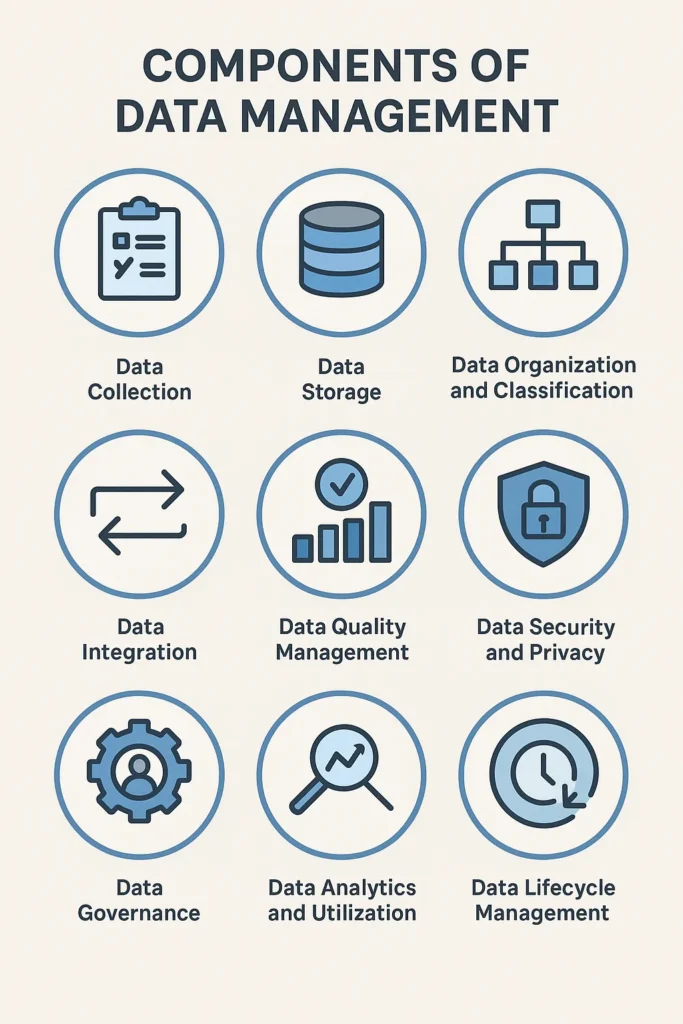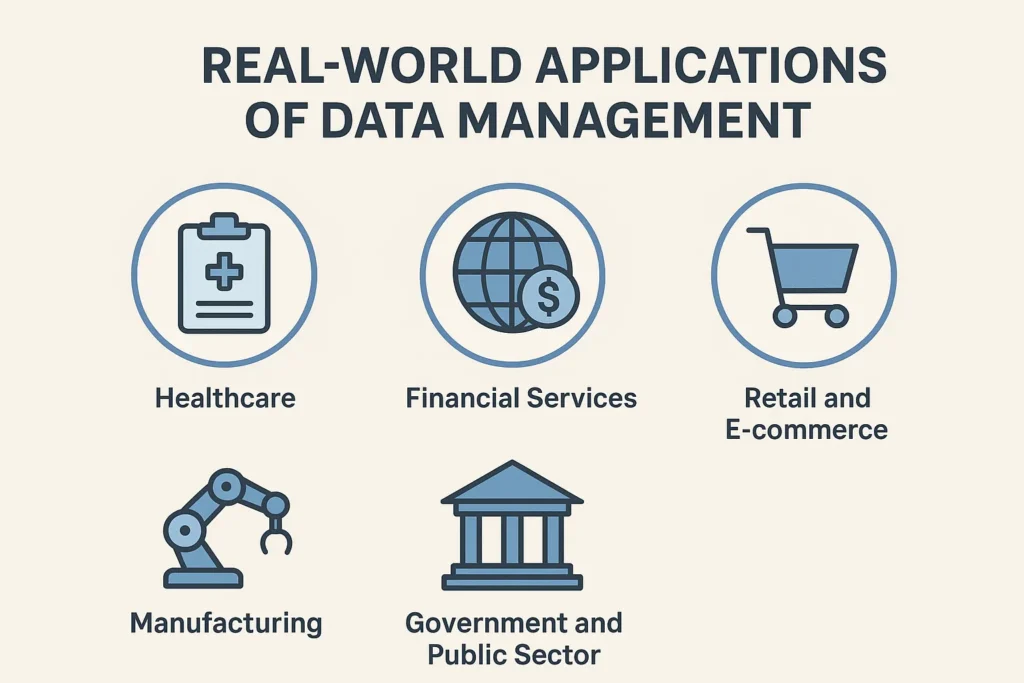
Executive Summary
Data management is the process of collecting, storing, organizing, protecting, and utilizing data to support decision-making, business operations, and strategic goals. In an era dominated by digital transformation, organizations generate vast amounts of data daily—from customer interactions and transactions to sensor readings and social media activity. Managing this data effectively ensures accuracy, accessibility, security, and compliance, enabling organizations to derive value and insights while mitigating risks.
This guide explores what data management is, its components, strategies, tools, benefits, challenges, and future trends. It provides a comprehensive understanding for IT professionals, business leaders, data analysts, and organizations aiming to leverage data as a strategic asset.
Table of Content
Introduction
Data is often called the “new oil” of the digital economy. However, raw data has little value unless it is properly managed, structured, and analyzed. Data management transforms raw information into actionable insights that guide decision-making, enhance operational efficiency, and drive innovation.
Data management encompasses processes, policies, technologies, and practices that ensure data is accurate, secure, and readily available. Effective data management reduces redundancy, prevents errors, improves compliance, and maximizes the utility of data across the organization.
Origins and Evolution of Data Management
Data management has evolved alongside computing and information systems:
Key Milestones:
- Manual Record-Keeping (Pre-1950s) – Early businesses relied on ledgers, card catalogs, and filing systems to track information.
- Database Systems (1960s–1970s) – The development of relational databases enabled structured storage and retrieval of data.
- Enterprise Data Management (1990s) – Organizations adopted centralized databases to integrate and manage business data.
- Big Data Era (2010s–Present) – Explosion of digital data from online platforms, IoT devices, and cloud computing created new challenges and opportunities.
- Modern Data Management (Today) – Advanced technologies, AI, cloud infrastructure, and governance frameworks enable scalable, secure, and intelligent data management.
Core Principles of Data Management
Effective data management is guided by several foundational principles:
- Data Accuracy – Ensuring that data is correct, reliable, and free from errors.
- Data Integrity – Maintaining consistency, completeness, and trustworthiness of data over its lifecycle.
- Data Accessibility – Making data available to authorized users when needed.
- Data Security – Protecting data from unauthorized access, breaches, and cyber threats.
- Data Governance – Implementing policies and standards for managing data effectively.
- Data Compliance – Ensuring adherence to legal, regulatory, and industry standards.
- Data Lifecycle Management – Managing data from creation and storage to archiving or deletion.
Components of Data Management
Data management is a multi-disciplinary practice that combines technology, processes, and governance:

1. Data Collection
- Definition: Capturing data from various sources, such as transactions, social media, sensors, or third-party providers.
- Best Practices: Automated collection, validation rules, real-time capture, and minimizing errors.
2. Data Storage
- Definition: Storing data in databases, data warehouses, or cloud systems.
- Techniques: Relational databases, NoSQL databases, data lakes, and cloud storage solutions.
- Considerations: Scalability, cost, redundancy, and accessibility.
3. Data Organization and Classification
- Definition: Structuring and categorizing data to make it usable.
- Methods: Metadata tagging, indexing, data models, taxonomies, and hierarchical organization.
4. Data Integration
- Definition: Combining data from different sources to provide a unified view.
- Tools: ETL (Extract, Transform, Load) processes, APIs, and data pipelines.
- Benefits: Enhanced analytics, reporting accuracy, and operational efficiency.
5. Data Quality Management
- Definition: Ensuring data is accurate, complete, consistent, and timely.
- Processes: Data cleansing, validation, deduplication, and continuous monitoring.
6. Data Security and Privacy
- Definition: Protecting data from unauthorized access and breaches.
- Techniques: Encryption, access control, multi-factor authentication, and monitoring.
- Compliance Standards: GDPR, HIPAA, CCPA, and ISO 27001.
7. Data Governance
- Definition: Establishing policies, roles, responsibilities, and standards for managing data.
- Functions: Defining data ownership, data stewardship, and regulatory compliance.
8. Data Analytics and Utilization
- Definition: Turning data into insights through analysis, visualization, and reporting.
- Methods: Business intelligence (BI), predictive analytics, machine learning, and AI-powered analytics.
9. Data Lifecycle Management
- Definition: Managing data from creation through archiving or deletion.
- Objectives: Optimize storage, comply with regulations, and ensure data remains relevant.
Data Management Processes
A structured approach to data management ensures consistency, reliability, and efficiency:
1. Planning
- Define objectives, data requirements, and governance frameworks.
2. Acquisition and Capture
- Collect data from internal and external sources while ensuring quality and accuracy.
3. Storage and Organization
- Store data securely, classify it, and maintain metadata for easy retrieval.
4. Integration and Transformation
- Merge data from multiple sources, normalize formats, and prepare for analysis.
5. Maintenance and Monitoring
- Continuously monitor data quality, validate new entries, and ensure security compliance.
6. Analysis and Reporting
- Apply analytical tools to generate insights, dashboards, and reports for decision-making.
7. Archiving and Disposal
- Retire outdated or irrelevant data safely while complying with legal and regulatory requirements.
Related Articles to Explore
Data management is closely connected with business operations, analytics, and technology-driven roles. Explore these related guides:
- How to Become a Data Scientist – Learn how strong data management skills form the foundation for a data science career.
- What Does a Data Engineer Do? – Discover how data engineers use structured management practices to maintain reliable data pipelines.
- What Is Business Management? – See how proper data management supports decision-making in organizations.
- What Is Knowledge Management? – Explore how capturing and sharing information enhances operational efficiency.
- What Is Project Management? – Understand how project managers rely on accurate data for planning and reporting.
Roles in Data Management
Data management relies on skilled professionals with defined responsibilities:
- Data Manager / Data Officer – Oversees overall data strategy, governance, and compliance.
- Data Analyst – Interprets data to generate insights and reports.
- Data Scientist – Uses advanced analytics and machine learning to identify trends and patterns.
- Database Administrator (DBA) – Manages databases, ensures uptime, and optimizes performance.
- Data Steward – Ensures data quality, accuracy, and adherence to standards.
- IT Security Specialist – Protects data against breaches and ensures regulatory compliance.
Tools and Technologies in Data Management
Organizations leverage advanced tools to handle large volumes of data effectively:
- Databases: Oracle, MySQL, PostgreSQL, Microsoft SQL Server.
- Data Warehouses: Snowflake, Amazon Redshift, Google BigQuery.
- Data Lakes: Hadoop, AWS S3, Azure Data Lake.
- ETL Tools: Talend, Informatica, Apache Nifi.
- Data Governance Tools: Collibra, Alation, Informatica Axon.
- Analytics & BI Tools: Tableau, Power BI, Looker, Qlik.
- AI & Machine Learning Platforms: TensorFlow, PyTorch, DataRobot.
- Security Tools: Encryption software, IAM (Identity Access Management), SIEM systems.
Benefits of Data Management
Proper data management delivers significant advantages:

- Enhanced Decision-Making – Reliable data enables informed strategic choices.
- Operational Efficiency – Streamlined processes and reduced redundancy improve productivity.
- Regulatory Compliance – Ensures adherence to laws like GDPR, HIPAA, and CCPA.
- Risk Mitigation – Reduces errors, fraud, and data breaches.
- Cost Savings – Optimized storage, reduced duplication, and efficient data usage save resources.
- Competitive Advantage – Leveraging data insights drives innovation and market positioning.
- Scalability – Structured processes support growth and expansion.
Challenges in Data Management
Organizations face several obstacles in managing data effectively:
- Data Volume and Velocity – Managing massive amounts of fast-growing data.
- Data Variety – Handling structured, semi-structured, and unstructured data.
- Data Quality Issues – Errors, duplication, and inconsistencies impact reliability.
- Integration Complexity – Combining data from multiple systems and formats.
- Security and Privacy Risks – Preventing unauthorized access, breaches, and compliance violations.
- Resource Constraints – Skilled personnel and technology investments are necessary.
Data Management Metrics and KPIs
Measuring data management performance ensures continuous improvement:
- Data Accuracy Rate – Percentage of correct, error-free records.
- Data Completeness – Proportion of records with all required fields filled.
- Data Timeliness – Speed at which data is available for use.
- Data Consistency – Uniformity of data across systems and platforms.
- Compliance Metrics – Adherence to regulatory requirements.
- Data Utilization Rate – Frequency and effectiveness of data usage in decision-making.
Data Management Strategies
Effective data management strategies focus on:
- Implementing Data Governance – Establish clear policies, roles, and standards.
- Ensuring Data Quality – Regular cleaning, validation, and monitoring.
- Adopting Scalable Storage Solutions – Cloud or hybrid systems to handle growth.
- Enhancing Security and Compliance – Encrypt data and enforce access controls.
- Integrating Analytics – Use BI, AI, and ML tools to extract actionable insights.
- Training and Culture – Promote data literacy and accountability across the organization.
Real-World Applications of Data Management

- Healthcare – Patient records, clinical data, and research information are managed to improve care and comply with regulations.
- Financial Services – Banks and investment firms rely on accurate data for risk assessment, reporting, and decision-making.
- Retail and E-commerce – Customer data, inventory, and sales analytics optimize operations and marketing.
- Manufacturing – Sensor data and supply chain information improve production efficiency.
- Government and Public Sector – Data management supports policy-making, citizen services, and transparency.
Common Misconceptions
- Data Management is Only About Storage – It involves collection, quality, governance, security, and analysis.
- More Data is Always Better – Quality and relevance matter more than sheer volume.
- Technology Alone Solves Data Problems – Skilled personnel and governance are equally critical.
- Data Management is One-Time – Continuous monitoring, maintenance, and improvement are necessary.
Steps to Implement Data Management
- Assess Data Needs – Understand organizational data requirements and objectives.
- Establish Governance Framework – Define roles, policies, and standards.
- Select Appropriate Tools – Choose storage, analytics, and governance systems.
- Implement Security Measures – Encrypt data, manage access, and comply with regulations.
- Ensure Data Quality – Validate, clean, and monitor data continuously.
- Integrate Analytics and Reporting – Make data actionable through visualization and insights.
- Train Staff and Promote Culture – Encourage data literacy and accountability.
- Continuously Monitor and Improve – Adapt processes as data needs evolve.
Future of Data Management
The future of data management is shaped by technology, regulation, and organizational needs:
- AI and Machine Learning – Automate data cleaning, classification, and predictive analytics.
- Cloud and Hybrid Data Management – Scalable solutions for growing data volumes.
- Real-Time Data Processing – Support instant insights for fast-paced decision-making.
- Enhanced Data Governance – Stricter regulations and compliance demands.
- Data Monetization – Turning data into strategic business assets for revenue growth.
- Integration of IoT and Edge Computing – Managing data from distributed devices efficiently.
Conclusion
Data management is a critical organizational discipline that transforms raw information into valuable insights. By integrating collection, storage, organization, security, governance, and analytics, organizations can ensure data accuracy, accessibility, and utility. Effective data management improves decision-making, operational efficiency, regulatory compliance, and competitive advantage. As organizations continue to generate ever-increasing volumes of data, mastering data management will be essential for long-term success and innovation.


